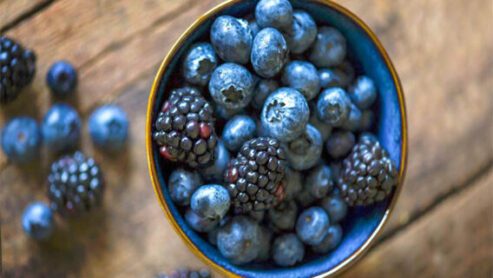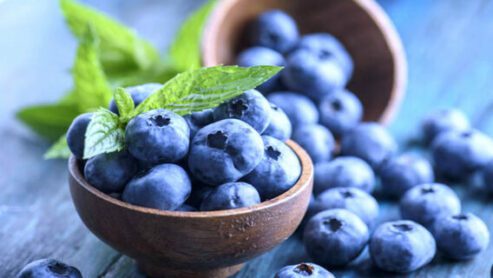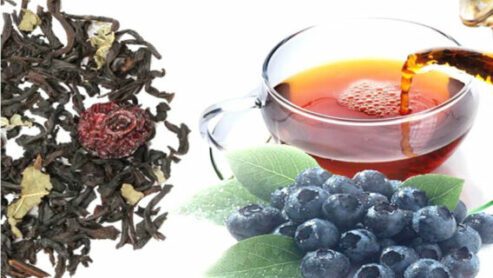Do you like healthy blue foods? Blueberries, blue corn tortilla chips, and blueberries are just a few of the many foods that come to mind when we think about the color blue and what it means in one’s diet.
Foods like blueberries and other fruits or vegetables may be high in antioxidants and can help reduce inflammation in your body.

There are plenty of ways to incorporate Blue into your diet without having to worry about whether or not you’ll get enough nutrients from all your meals!
Blue Healthy Foods: A Colorful Way to Wellness
What gives certain fruits and vegetables their deep indigo hue, and why should you care? Let’s explore the health benefits of the vibrant pigments in blue/purple foods.
Blueberries, blackberries, plums, eggplants, and purple cabbage—what do all of these colorful plant foods have in common? Their rich shades of blue and purple indicate high levels of health-protective compounds called anthocyanins.
Anthocyanins act as antioxidants in fruits and veggies. They help combat inflammation, reduce cellular damage, improve communication between cells, and more. Population studies link diets high in anthocyanin-rich foods to lower risks of chronic illnesses.
What Are Blue Healthy Foods?
When we talk about “blue foods,” we’re generally referring to fruits and vegetables containing natural pigments that appear deep blue, purple, or reddish-purple. Some common examples include:
- Berries: blueberries, blackberries, acai berries
- Stone fruits: plums, purple figs
- Cruciferous veggies: purple cabbage, radishes
- Nightshades: eggplants, purple potatoes
- Legumes: black beans, black soybeans
So, what makes these plants flaunt their bold “blue” hues? The answer lies in the anthocyanin pigments inside their cells.
Anthocyanins: Blue Foods’ Colorful Compounds
Anthocyanins belong to a particular class of antioxidants called flavonoids. They’re water-soluble plant compounds concentrated in the peels, flesh, leaves, roots, seeds, or flowers of various fruits and veggies.
There are over 600 identified anthocyanins that differ based on their chemical structure. Foods containing the highest levels include:
- Berries: blackberries, blueberries, strawberries, raspberries
- Red/purple grapes
- Cherries
- Pomegranates
- Plums
- Eggplants
- Purple corn
- Purple cabbage/kale
Anthocyanins act as vibrant pigments that tint certain foods red, purple, or blue. Their colors can change based on acidity levels. More acidic conditions cause anthocyanins to appear more red. Higher pH leads to hues shifting purple/blue.
It’s this chameleon-like quality that gives foods like red cabbage or purple carrots their stunning shades. Now, let’s uncover why these colorful antioxidants are so great for our health.
Why Are Blue Foods Healthy?
Anthocyanins belong to the polyphenols group. As antioxidants, they help counter oxidative damage and inflammation in the body.
Chronic inflammation drives numerous age-related diseases. It’s why diets rich in anti-inflammatory, anthocyanin-containing foods correlate to lower risks for:
- Cancer
- Heart disease
- Obesity
- Diabetes
- Neurodegenerative disorders
- Vision/eye problems
Additionally, research reveals specific benefits linked to anthocyanins:
Cardioprotective Effects
Heart disease remains the #1 global killer. Yet anthocyanins support several aspects of heart health:
- Lower “bad” LDL cholesterol
- Decrease blood pressure
- Improve blood flow by promoting flexible arteries
- Prevent blood clots through anticlotting effects
Reduced Cancer Risk
Cancer starts when damaged cells divide uncontrollably. Anthocyanins may inhibit tumor growth by:
- Triggering cancer cell death (apoptosis)
- Blocking abnormal proliferation of malignant cells
- Cutting off blood supply to tumors (anti-angiogenesis)
Studies associate higher dietary anthocyanins with lower gastric, esophageal, and colorectal cancer rates. Anthocyanin-rich berries also suppress oral, skin, and prostate tumor growth in lab trials.
Better Blood Sugar Control
Over time, uncontrolled blood sugar creates devastating complications like nerve damage, blindness, kidney failure, and atherosclerosis. Anthocyanins boost glycemic control through multiple mechanisms:
- Increasing insulin secretion/sensitivity
- Supporting the survival of insulin-producing pancreatic beta cells
- Slowing carbohydrate digestion/absorption
One analysis found that anthocyanin intakes >45 mg/day cut diabetes risk by 23% versus <2 mg/day.
Enhanced Brain Function
Oxidative stress and inflammation drive cognitive decline. As antioxidants, anthocyanins safeguard delicate brain tissue on multiple fronts, including:
- Shielding neurons’ membranes and DNA
- Increasing blood flow + oxygen to the brain
- Stimulating neuron signaling
- Promoting synapse formation
- Reducing plaque formation
Diets richer in anthocyanin-laden blueberries improve memory, processing speed, and motor coordination in human trials.
Incorporating Blue Foods into Your Diet
Hopefully, you’re now convinced of the merits of eating more blue/purple produce, thanks to those valuable anthocyanins!
But how much should you eat for maximum benefits? And what are some quick ways to fit in more fruits and veggies with that gorgeous indigo tint?
How Much Per Day?
Studies suggest effective anthocyanin doses may range from 90–500 mg daily. But even small, gradual boosts can move the needle.
To reach 90 mg/day, you’d need 1.5 cups of blueberries. Not bad! Yet research indicates greater intakes (upwards of 500 mg) may provide more optimal benefits.
That higher target means fitting in about 2.5 cups of blueberries or 2 cups of blackberries per day. Ambitious? Definitely! But here are realistic ways to mix in more blue/purple produce each week:
| Food | Serving Size | Approx. Anthocyanins (mg) |
|---|---|---|
| Blackberries | 1 cup | 179 |
| Blueberries | 1 cup | 117 |
| Black raspberries | 1 cup | 112 |
| Purple grapes | 1 cup | 93 |
5 Easy Ways to Eat More Blue Foods
- Breakfast: Top yogurt or oatmeal with fresh or thawed blueberries, blackberries, or acai puree.
- Smoothies: Blend blueberries, blackberries, purple grapes, or cherries into fruit smoothies or green smoothies.
- Salads: Toss blueberries or blackberries into leafy or grain-based salads. Mix in shredded red cabbage or radishes, too.
- Snacks: Enjoy freshly washed berries, sliced plums, or purple figs for a quick snack.
- Sides: Roast eggplant, purple potatoes, or purple carrots to accompany main dishes like chicken, meat, or fish. Stir-fry purple cabbage or kale.
Blue Food Challenges and Solutions
Many blue/purple fruits and vegetables spoil rapidly or get bruised/damaged easily during shipping. Thankfully, practical solutions exist!
Limited Seasonality
Berries thrive during warmer months. But other fruits/veggies like grapes, plums, and cruciferous varieties last well into fall. You can also freeze picked-at-peak berries to enjoy year-round.
Quick Spoilage
Soft fruits like berries don’t store long. But pre-washing and then freezing extends freshness for smoothies or baking. Canning or individually quick-freezing (IQF) berries also helps. Or consider dried options like raisins, cranberries, or freeze-dried blueberries.
Susceptibility to Bruising/Damage
From farm to table, delicate berries get frequently crushed. Buying firm, intact packaged berries or growing your own maximizes anthocyanins. Another tip? Rinse berries right before eating to minimize water-induced mold growth.
Limited Availability
If your grocery store lacks variety beyond berries and red grapes, check global markets or specialty stores. Many carry exotic berries like goji or unique purple veggies like sweet potatoes. And consider planting hardier blue/purple crops like cabbage or eggplants in your backyard garden!
What Makes Blue Foods Special?
Thanks to those colorful antioxidant pigments called anthocyanins, deep blue/purple fruits and veggies confer some fantastic benefits for health.
From cancer protection to better blood sugar control, they are brimming with free-radical fighting and inflammation-quelling power.
Research continues to elucidate how precisely these plant compounds promote wellness and curb disease. But one thing’s for sure based on what we know already: you can harness food as preventive medicine by filling your plate with nature’s vibrant rainbow.
So be brave and branch beyond neutrally-colored staples. Besides their visual appeal, those deep jewel tones signify therapeutic potential.
It’s time to think outside the box when hitting the produce aisle or designing your garden landscape!
Why not challenge yourself to try a new blue/purple fruit or vegetable each week? Your quest will deliver valuable antioxidants, added culinary intrigue, and the inner glow that comes with expanding your nutritious repertoire.
Top 10 Delicious Blue Healthy Foods For You To Try At Home:
1. Blueberries:

Blueberries are one of the most famous bluefoods around because they’re so easy to find in grocery stores, markets, and even farmers’ markets.
Blueberries are great for making desserts or adding to your cereal in the morning.
2. Blue Corn Tortilla Chips:
There are plenty of corn tortilla chips out there, but if you’re looking to get a healthy dose of antioxidants, fiber, and other nutrients, you’ll want to try blue corn tortilla chips.
Dipping them in salsa or guacamole can add some flavor and texture, so give it a try the next time you have some on hand!
3. Watermelon:
Who doesn’t love watermelon? It’s a great summertime treat, and with its bright red color, it makes a statement in your fruit bowl. Watermelon is also one of the best foods to eat if you’re looking for something hydrating instead of sugary or salty!
4. American lobster:
American lobster is a great way to get your omega-3 fatty acids. You can eat it with melted butter or have it cold with some lemon juice.
5. Blue crab:
Blue crab is another healthy seafood choice because of all the nutrients that it has to offer! It’s also one of the least expensive types of crab that you can find, so it’s great for people looking to save money.
6. Blueberry Cheesecake:
Why not try making your own blueberry dessert at home for those who prefer desserts over main courses?
You don’t need to go out or buy anything fancy because all you need is some blueberries and a recipe for a blueberry cheesecake!
Blueberries can go in many desserts because they add a nice flavor and texture to the dish.
7. Blue raspberry:
Blue raspberry is one of the most popular flavors for candy and other tasty snacks that people like to eat.
If you want to get that flavor but don’t want all of the additives with most blue raspberry snacks, why not try it out with some naturally flavored organic foods?
8. Blueberry tea:

If you like tea but aren’t a fan of coffee, why not try making your blueberry tea at home? You can keep this in the fridge and drink it throughout the day whenever you feel thirsty or have a craving for something sweet.
9. American cheese:
American cheese is one of the most versatile types of cheese because it can be used to make so many different recipes!
You can use it in soups, sandwiches, and even on pizzas. Try melting some American cheese and use it as a dip for your blue tortilla chips.
10. Blue moon ice cream:
When you want something sweet and creamy, why not give this ice cream flavor a try? It’s not easy to find, but you might just find it at your local grocery store or specialty shop if you keep looking.
Is blue food healthy?
Yes, blue food can be very healthy because many of these foods contain antioxidants, which can help prevent cancer and reduce inflammation. Blue food is healthy because of the nutrients that it offers, such as antioxidants and other vitamins.
The most notable nutrient in blue food is the antioxidant anthocyanin. This antioxidant can be found in many different foods, including blueberries, black rice, and red cabbage.
What Are The Benefits Of Blue Foods?
Blue foods have many benefits because they’re a great source of nutrients and antioxidants. Some blue foods that you can eat to benefit your health include:
- Blueberries for their antioxidants
- Red cabbage for anthocyanins
- Black rice for its fiber content
- The American lobster, blue crab, and blue cheese for omega-3 fatty acids
- Blueberries, blue raspberry, and blue cheese for their excellent flavor and texture
The health benefits of these foods include better cardiovascular health, a more robust immune system, and a lower risk of cancer.
Most people don’t realize that there are so many ways to incorporate blue food into various dishes to benefit your health!
Conclusion
In this blog post, we talked about the benefits of eating blue foods and how they can help you lose weight by reducing your appetite.
We mentioned some delicious recipes for making these healthy dishes at home, like an easy blueberry smoothie recipe or a spicy tuna roll with cucumbers and avocado.
If you have any questions, please leave us a comment in the comments section below!
